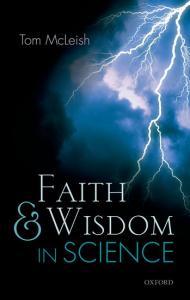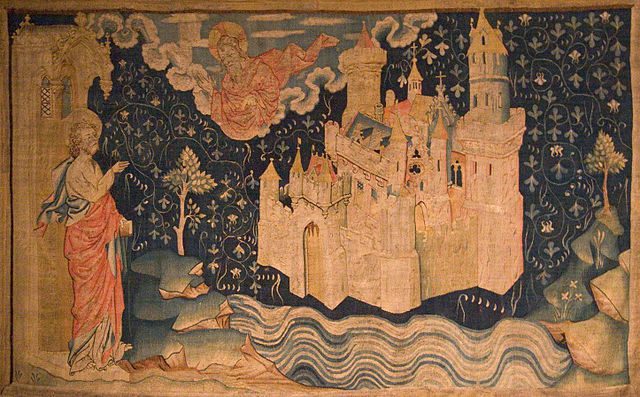 Tom McLeish in his book Faith & Wisdom in Science explores the New Testament approach to creation – especially in Paul’s letters, the Gospel of John and Revelation. McLeish notes that recent scholarship has emphasized Paul as “in continuity with the hope of Old Testament Judaism, perceiving the Christian church as the way to fulfil, rather than to negate, the law and prophets.” (p. 152) The Jewish story of creation is a story with a beginning, middle, and end. The end involves a future reconciled and reconstituted world. Paul sees this story as expanded beyond Jews to include Gentiles as well. Romans makes this argument quite clearly, connecting accountability not only to the law (given to Israel and the Jews) but also to the very nature of creation (Romans 1).
Tom McLeish in his book Faith & Wisdom in Science explores the New Testament approach to creation – especially in Paul’s letters, the Gospel of John and Revelation. McLeish notes that recent scholarship has emphasized Paul as “in continuity with the hope of Old Testament Judaism, perceiving the Christian church as the way to fulfil, rather than to negate, the law and prophets.” (p. 152) The Jewish story of creation is a story with a beginning, middle, and end. The end involves a future reconciled and reconstituted world. Paul sees this story as expanded beyond Jews to include Gentiles as well. Romans makes this argument quite clearly, connecting accountability not only to the law (given to Israel and the Jews) but also to the very nature of creation (Romans 1).
Refiner’s fire, pangs of childbirth, the sprouting of new growth.
The current state of the world is cast in terms of anticipation. Romans 8 makes this most clearly.
I consider that our present sufferings are not worth comparing with the glory that will be revealed in us. For the creation waits in eager expectation for the children of God to be revealed. For the creation was subjected to frustration, not by its own choice, but by the will of the one who subjected it, in hope that the creation itself will be liberated from its bondage to decay and brought into the freedom and glory of the children of God.
We know that the whole creation has been groaning as in the pains of childbirth right up to the present time. Not only so, but we ourselves, who have the firstfruits of the Spirit, groan inwardly as we wait eagerly for our adoption to sonship, the redemption of our bodies. (c. 18-23)
The picture of anticipation changes the impact of the passage from past to future. McLeish comments on this and then digs deeper into the “glory” to come.
The present pain is not to be interpreted as the pain of decay, disease and dissolution, but rather the pain of childbirth, the necessary process by which new life comes into being. (p. 154)
The “freedom and glory of the children of God” is a difficult passage to interpret. McLeish, reading N.T. Wright, suggests that our anticipation, according to Paul, is for a reconciled and reconstituted world. The “freedom and glory” belongs to all creation when the children of God are in right relationship with the world. “Within his [Paul’s] theology this only happens when they are also in a right relationship with God.” (p. 156)
1 Corinthians also focuses on anticipation, although the imagery is a little different. Rather than childbirth we find a seed used in analogy with resurrection.
When you sow, you do not plant the body that will be, but just a seed, perhaps of wheat or of something else. But God gives it a body as he has determined, and to each kind of seed he gives its own body. … So will it be with the resurrection of the dead. The body that is sown is perishable, it is raised imperishable; it is sown in dishonor, it is raised in glory; it is sown in weakness, it is raised in power; it is sown a natural body, it is raised a spiritual body. (15: 37, 42-44)
Resurrection and renewed creation will have the same relationship and continuity with the present creation that a plant has with the seed from which it sprang.
He [Paul] believes that the process of planting and rebirth, or of resurrection itself, is no longer postponed to an indefinite future, but a process that has already begun by the planting of one particular human ‘seed’ (1 Corinthians 15:49) … A tiny ‘bubble’ of the new created world order nucleates at the first Easter. But it does sweep all nature before it in passivity. Instead there is an implicit invitation to participate in the coming into being of renewed creation. (p. 159)
Turning to the Gospel of John the most significant passage is the opening. In the beginning was the Word, and the Word was with God, and the Word was God. … The Word became flesh and made his dwelling among us. We have seen his glory, the glory of the one and only Son, who came from the Father, full of grace and truth. (1:1, 14) The key point in this passage is the connection of Jesus with God setting the stage for the Christian doctrine of Trinity – at least as concerns the first and second persons. More than this, “Jesus is standing in a balanced and healthy relation to the physical world: it responds to his command with fruitfulness, but his command is not out of tune with its nature.” (p. 162)
 This sets the stage for St. John’s Revelation. McLeish is content to connect both the Gospel and Revelation with the same authority.
This sets the stage for St. John’s Revelation. McLeish is content to connect both the Gospel and Revelation with the same authority.
Then I saw ‘a new heaven and a new earth,’ for the first heaven and the first earth had passed away, and there was no longer any sea. saw the Holy City, the new Jerusalem, coming down out of heaven from God, prepared as a bride beautifully dressed for her husband. And I heard a loud voice from the throne saying, ‘Look! God’s dwelling-place is now among the people, and he will dwell with them. They will be his people, and God himself will be with them and be their God. “He will wipe every tear from their eyes. There will be no more death” or mourning or crying or pain, for the old order of things has passed away.’ (21:1-4)
McLeish draws four conclusions. First, there is a radical new order where chaos (signified by the sea) is not only contained, but is absent. Second, the new order descends, overwhelms, and transforms the old. Third, God dwells with and in the recreated world. Fourth, pain and suffering are erased from the picture.
The overall image from both Paul and John is one of rebirth and renewal, restoration and transformation. McLeish argues against the idea of heaven as some otherworldly immaterial place divorced from the material world in which we currently live. Rather than the destruction of the material world, we have consummation fulfilling God’s ultimate plan. The pangs of childbirth, the sprouting of new life from a seed, the new heaven and the new earth. These are all images of hope for the future growing in some sense from the present creation.
What is the overall vision for creation in the New Testament?
How is this vision a continuation of the Old Testament vision found in Genesis, Job, the Psalms and Prophets?
If you wish to contact me directly you may do so at rjs4mail[at]att.net.
If interested you can subscribe to a full text feed of my posts at Musings on Science and Theology.















